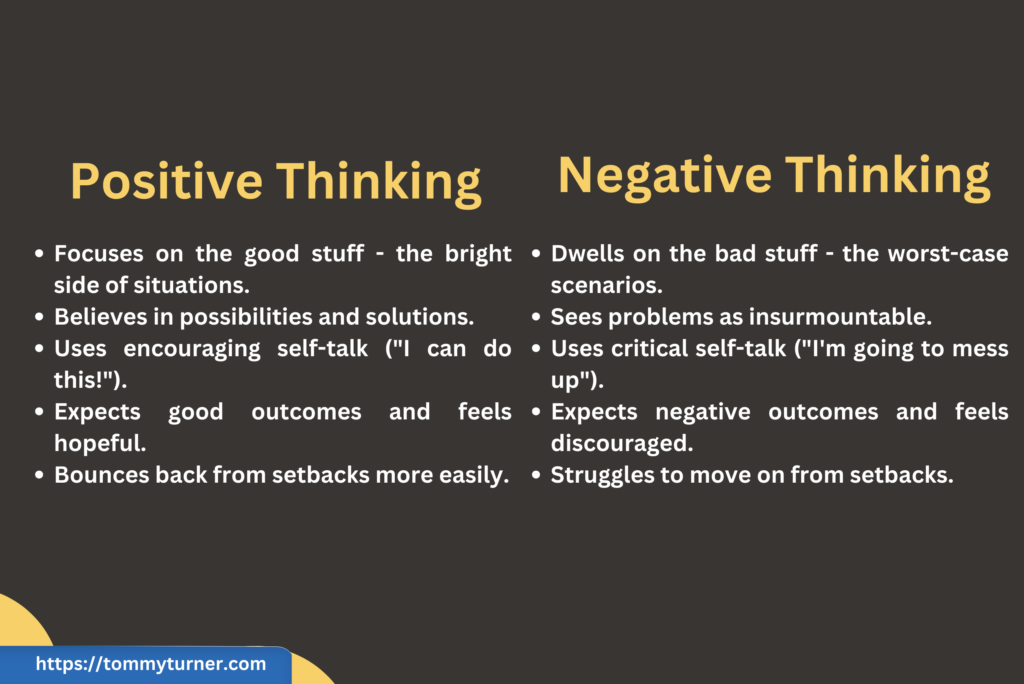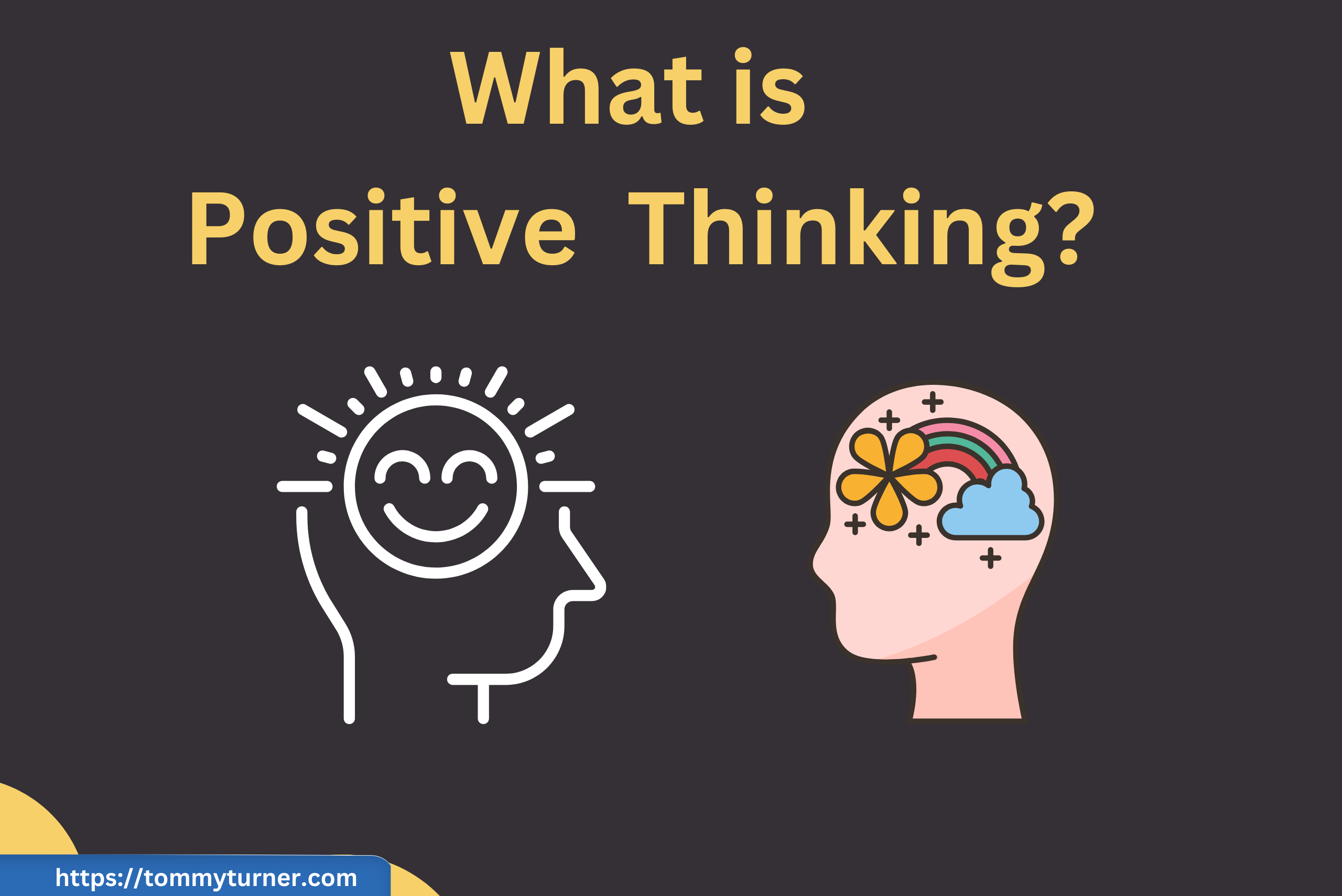Life can be tough sometimes, right? Stress can really bring you down. Lots of people deal with negative thoughts, and it can make you feel awful.
But guess what? There’s a simple way to feel happier and healthier! Positive thinking is a superpower that can change how you see the world and make you feel awesome. No more feeling like things are out of your control – positive thinking lets you be the boss of your own happiness.
Sound cool? Keep reading! I’ll show you how easy it is to think more positively and become a happier, healthier you!
But first let’s take a good look at what positive thinking is, shall we?
What is Positive Thinking?
The first thing I would want to you to do is to forget the fancy words and daydreams because first of all positive thinking isn’t about pretending life is perfect (trust me, things go wrong sometimes!).
It’s more like seeing the good stuff. It’s believing you can do things, even when they’re tough. It’s like having a happy voice in your head that says, “Hey, stop those bad thoughts! Look at the bright side!”
So, in short, positive thinking means that you approach negative news or stressful situations with a positive outlook. You’re able to look beyond the crisis or setback rather than being consumed by it.
Now let’s say you wake up, rain falls hard, and your car won’t go (it’s broken!). A sad voice says, “Ugh, this day is awful!” But a happy voice says, “Okay, car trouble is no fun, but at least I have coffee and a comfy chair. Maybe this is a good time to read that book I like!”
Do you see the difference? Positive thinking doesn’t forget the rain or the broken car, it just finds the happy things (and maybe enjoys that yummy coffee!).
Importance of Positive Thinking?
You might want to know the importance of positive thinking right? Let’s take a good look at some of them real quick.
Here’s the lowdown
- Less Stress: When you think positively, you don’t worry as much. It’s like having a built-in chill button – problems seem smaller and easier to handle.
- Happier You: Positive thinking puts a smile on your face inside and out! You feel more optimistic, which makes everything more enjoyable.
- Stronger Body: Believe it or not, positive thinking can even make you healthier! Studies show it can help you fight off illness and bounce back from setbacks faster. Pretty cool, right?
Are there Health Benefits of Positive Thinking?
Believe it or not, positive thinking can be a real health game-changer! Here’s the deal: when you’re stressed and negative, your body feels tense, right? You might even get headaches or stomach woes. Positive thinking, on the other hand, is like sunshine for your insides. It helps you relax and stay calm, which can have a surprising impact on your physical health.
But wait, there’s more! Science actually backs this up. A 2018 study in the Journal of Aging Research found that people with a more positive outlook had a lower risk of death over a 35-year period! Now, that’s a pretty impressive statistic.
Here’s how it might work: positive thinking can boost your immune system, the body’s army against illness.
Studies suggest it can help you fight off those pesky colds and flu more effectively. Plus, feeling optimistic can lead to healthier habits, like eating nutritious foods and getting enough sleep – all things that contribute to a strong body.
So, the data is clear: positive thinking isn’t just about feeling good, it can actually make your body stronger too!
Now let’s have a look at it is a more comprehensive way. Ladies and gentlemen, I present to you the health benefits of positive thinking, to help us build on what we’ve already discussed;
- Reduced Stress and Anxiety
Positive thinking helps you focus on the good and find solutions to problems, leading to a calmer and more relaxed state. This can significantly reduce stress hormones like cortisol, which are linked to a variety of health problems.
- Stronger Immune System
Studies suggest positive thinking can boost your immune system’s effectiveness. Positive emotions may increase the production of antibodies and white blood cells, which fight off illness.
- Lower Blood Pressure
Chronic stress can contribute to high blood pressure. Positive thinking can help manage stress and potentially lower blood pressure, reducing the risk of heart disease.
- Faster Healing
Positive thinking can improve your body’s ability to heal from injuries or illnesses. Feeling optimistic can also lead to better adherence to treatment plans, contributing to a faster recovery.
- Improved Sleep
When you’re stressed and negative, it can be harder to fall asleep and stay asleep. Positive thinking can promote relaxation and better sleep quality, which is crucial for overall health and well-being.
- Healthier Lifestyle Choices
Positive thinkers are more likely to make healthy choices, like eating nutritious foods, exercising regularly, and avoiding unhealthy habits. This can significantly improve your overall health and well-being.
- Increased Longevity
As mentioned earlier, research suggests a link between positive thinking and a longer lifespan. A positive outlook can contribute to better health behaviors and a stronger ability to cope with stress, both of which can lead to a longer life.
What does Science say about Positive Thinking?
Alright, alright, we’ve talked about how awesome positive thinking is for your health and happiness. But what does science say about it?
Let’s ditch the sunshine and rainbows metaphor for a second and get right into some real research.
Scientists are still figuring out the exact connection, but studies have shown a clear link between a positive mindset and various health benefits.
Remember that 2018 study we mentioned? Well, that wasn’t the only one!
Here’s a glimpse into what science is still discovering;
- The Brain Boost: Positive thinking activates different parts of your brain compared to negative thinking. Studies suggest it can enhance cognitive function, memory, and even creativity.
- Stress Buster: Positive emotions can down-regulate the stress response system. This means your body releases fewer stress hormones, leading to lower blood pressure and a calmer nervous system.
- The Healing Power of Optimism: Research suggests positive thinking can improve your body’s ability to heal from wounds and illnesses. It might even influence how well your immune system fights off germs.
This is just a taste of what science is discovering about the power of positive thinking. \
It’s a fascinating field of research, and scientists are constantly learning more about the mind-body connection.
How to practice “Positive thinking”

Alright everyone, enough talk, let’s get to the good stuff! We’ve seen how awesome positive thinking is and how science is backing it up.
But how do we train our brains to think more positively? Buckle up, because we’re about to become positivity ninjas!
Here are some powerful techniques to get you started, with some extra details to help you master them;
1. Challenge Negative Thoughts:
That nagging inner voice telling you you can’t do something? Catch it in the act! When a negative thought pops up, challenge it. Ask yourself, “Is this thought helpful? Is it realistic?”
- Example: You’re about to give a presentation and a negative thought whispers, “You’re going to mess up, everyone will laugh.” Challenge it! Ask yourself, “Have I messed up every presentation before? What can I do to prepare and feel confident?” Reframe the thought: “I’m prepared, I’ve practiced, and I can handle any questions.”
2. Focus on Gratitude:
Take some time each day, maybe even just a few minutes, to appreciate the good things in your life. Write down three things you’re grateful for, big or small.
Focusing on gratitude is a powerful way to shift your mindset toward the positive.
- Take it a Step Further: Try a gratitude jar! Write down things you’re grateful for on slips of paper, put them in a jar, and then on tough days, pull one out for a positivity boost.
3. Visualize Success:
Imagine yourself achieving your goals. Close your eyes and picture yourself feeling confident and accomplished. Visualization can help program your brain for success and boost your motivation.
- Spice it Up: Make your visualization as detailed as possible. Imagine yourself giving the perfect presentation, see the smiles on your audience’s faces, and hear the applause. The more vivid your visualization, the more powerful it can be.
4. Positive Self-Talk:
Ditch the inner critic! Treat yourself with kindness and encouragement. Talk to yourself the way you would talk to a good friend.
- Be Specific: Instead of a generic “I can do it,” try something like, “I’ve aced presentations before, and I can do it again. I’m prepared and I have great ideas to share.”
5. Surround Yourself with Positive People:
The people you spend time with can influence your thinking. Surround yourself with optimistic and supportive people who uplift and inspire you.
- Take Action: Maybe there’s a positive colleague you can have lunch with more often, or join a club focused on activities you enjoy and meet like-minded people.
6. Practice Mindfulness:
Mindfulness is about being present in the moment and appreciating the little things. Take some deep breaths, focus on your surroundings, and savor the good moments.
- Start Small: Begin with a few minutes of mindful breathing each day. Focus on your breath, feeling your chest rise and fall. Notice any thoughts that arise, but don’t judge them, simply let them go and return your attention to your breath.
You must have at the back of your mind that positive thinking is a skill, and like any skill, it takes practice.
I’ll always advise you don’t get discouraged if you have setbacks. Be patient with yourself and keep at it. The more you train your brain to think positively, the easier it will become!
Are there downsides to Positive Thinking?
We’ve been raving about positive thinking, and for good reason! But hold on a sec. Is it always sunshine and rainbows? Not quite. Here’s the thing:
- Ignoring Problems
Sometimes, focusing only on the good stuff can mean we forget about real problems. Imagine you have a leaky faucet. Positive thinking isn’t about pretending it doesn’t exist or hoping it magically fixes itself.
It’s about acknowledging the leak (it’s a problem!), staying optimistic you can fix it (you got this!), and taking action to get it repaired (call a plumber or grab some tools!).
- Expecting Too Much
Super positive thinking can trick us into thinking everything will be amazing, all the time, for ourselves and others. It’s good to be optimistic, but remember, life throws curveballs. Let’s say you’re up for a promotion.
Positive thinking means believing you can do a great job, but also being prepared if someone else gets it (maybe you can ask for feedback to improve your chances next time!).
- Feeling Like a Flop
If you’re always expecting the best and things go wrong, you might feel like a failure. Positive thinking doesn’t mean everything will be perfect. I
It’s about staying hopeful even when stuff gets tough. You bomb a test? Positive thinking: “Okay, that wasn’t great, but I can study harder next time and ace it!”
- Bottling Up Feelings
Positive thinking shouldn’t mean pretending you’re never sad, mad, or frustrated. Those feelings are normal! Let yourself feel them, but don’t let them take over.
Feeling down after a fight with a friend? Positive thinking: “This stinks, but maybe I can talk to them and work things out.”
- Skipping Lessons
Seeing everything through rose-colored glasses can make it hard to learn from mistakes.
Sometimes those mess-ups are great chances to grow! Did you forget your soccer practice jersey? Positive thinking: “Oops, next time I’ll pack my bag the night before so this doesn’t happen again!”
So, the bottom line is this: positive thinking is a superstar tool, but it’s not magic. Use it to be more optimistic, bounce back from problems more easily, and feel good overall.
Positive Thinking VS Negative Thinking
So far, we’ve talked about the power of positive thinking and the potential downsides.
But what exactly is the difference between positive thinking and negative thinking?
Below is a picture to help you understand their differences at a glace;

The Golden Mean:
Neither extreme is ideal. The key is to find a healthy balance, a kind of “golden mean” between positive thinking and negative thinking. Here’s what that looks like:
- Acknowledge Challenges: Don’t ignore problems, but don’t dwell on them either. Focus on finding solutions with an optimistic outlook.
- Be Realistic: Believe in yourself, but also be aware of potential obstacles. Set achievable goals and have backup plans.
- Learn from Mistakes: Don’t beat yourself up over setbacks. See them as opportunities to grow and improve.
- Embrace All Emotions: It’s okay to feel sad, angry, or frustrated sometimes. Allow yourself to feel these emotions, but don’t let them control you.
- Practice Gratitude: Focus on the good things in your life, big and small. This helps shift your perspective towards the positive.
Just by practicing these tips, you can develop a more balanced and realistic way of thinking. You’ll be able to see the good in situations, stay hopeful, and tackle challenges with a positive attitude.
It’s a Journey: How to Keep Thinking Positively
Without a doubt, we seen that positive thinking is a fantastic skill to have, but let’s be honest, life can get messy sometimes.
Those negative thoughts might creep back in, and that’s okay! Positive thinking is a journey, not a destination.
Here are some ways to keep your positivity muscle strong, even on tough days:
- Start Small: Don’t try to overhaul your thinking overnight. Begin with small, achievable goals. Maybe it’s replacing one negative thought with a positive one each day.
- Celebrate Victories: Acknowledge your progress, no matter how small. Did you catch yourself reframing a negative thought? Did you find a silver lining in a bad situation? Give yourself a mental high five!
- Practice Mindfulness: Mindfulness helps you stay present and focused on the good things happening right now. Take a few deep breaths, notice your surroundings, and appreciate the little things.
- Surround Yourself with Positivity: Spend time with optimistic and supportive people who uplift and inspire you. Limit your exposure to negativity, especially when you’re feeling down.
- Find Humor: Laughter is a great stress reliever and can shift your mood to a more positive place. Watch a funny video, read a comic strip, or spend time with someone who makes you laugh.
- Practice Gratitude: Take some time each day, even just a few minutes, to appreciate the good things in your life. Write down three things you’re grateful for or keep a gratitude journal.
- Focus on What You Can Control: You can’t control everything that happens in life, but you can control your reaction to it. Focus on the things you can influence and let go of the rest.
- Be Kind to Yourself: Don’t beat yourself up if you have a negative thought. Acknowledge it, and then gently redirect your thinking towards the positive. Treat yourself with kindness and compassion.
Frequently Asked Questions
Now, let’s take a look at some frequently asked questions regarding positive thinking;
Isn’t positive thinking just wishful thinking?
No! Positive thinking is backed by science and has been shown to have real health benefits. It’s about focusing on the good, but also acknowledging challenges and finding solutions with an optimistic outlook.
How can I train myself to be more positive?
There are many techniques you can use, like challenging negative thoughts, practicing gratitude, visualizing success, and surrounding yourself with positive people.
Are there any downsides to positive thinking?
While positive thinking is great, it’s important to be balanced. Don’t ignore problems or set unrealistic expectations. It’s okay to experience negative emotions, and setbacks can be valuable learning opportunities.
What if I have a bad day and can’t seem to stay positive?
Positive thinking is a journey, not a destination. There will be setbacks, but that’s okay! Here are some tips for staying positive on tough days, like focusing on what you can control, practicing mindfulness, and finding humor.
Final Thoughts
So far, we’ve been able to carefully look at what positive thinking is and isn’t, its benefits, and how to practice it.
One thing you shouldn’t forget is that it’s a skill you can develop with practice.
Don’t get discouraged if you have setbacks. Be patient with yourself and keep at it. The more you train your brain to think positively, the easier it will become.
Here’s the challenge: Pick one thing you can do today to boost your positive thinking. Maybe it’s writing down three things you’re grateful for, challenging a negative thought, or spending time with an optimistic friend.
Small steps lead to big changes!
About Tommy Turner:
Entrepreneur and author Tommy Turner brings over three decades of experience inspiring others through his journey in the piano industry, online marketing, stock trading, and motivational writing.
For more about Tommy’s journey and work, visit the about page, drop a line on the contact page or leave a comment in the comments section. Check out Tommy’s books!






